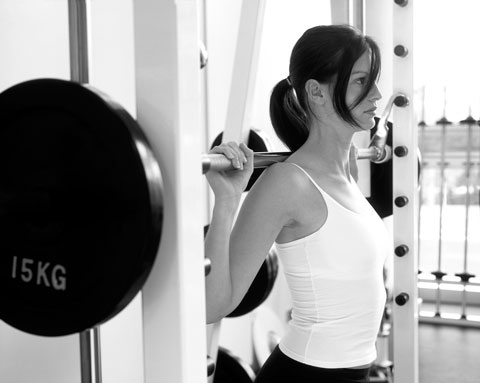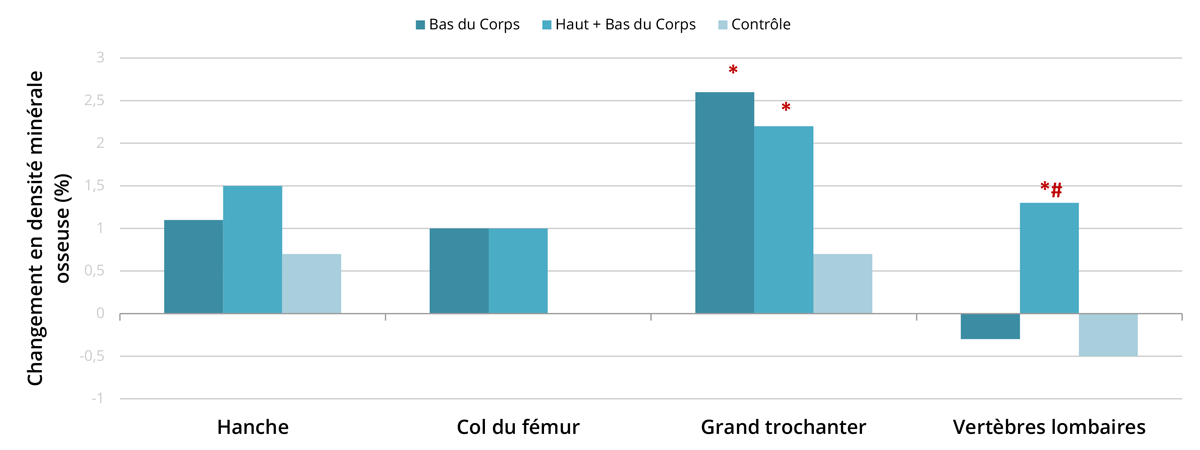L’entraînement avec bandes élastiques permet d’augmenter la densité minérale osseuse

Avec l’âge, la diminution de la densité minérale osseuse et l’apparition de l’ostéoporose sont de plus en plus prononcées. Chez la femme, ces facteurs de risque sont aggravés avec la ménopause (voir notre article). La densité minérale osseuse (DMO) est un index de la santé osseuse et permet d’évaluer dans une certaine mesure les risques de fractures. Plus la DMO diminue, plus les risques de fractures deviennent élevés. De plus, l’absence de pratique d’une activité physique diminue fortement les contraintes mécaniques appliquées sur les os et empêche ainsi leur renforcement. En effet, la loi de Wolff stipule que l’os se forme ou se résorbe en fonction des contraintes mécaniques qu’il subit.

L’espérance de vie augmentant, il est primordial de mieux vieillir. La perte de masse musculaire, l’augmentation de la masse grasse corporelle, et les risques de fractures accrus conduisent souvent les personnes âgées à une perte d’autonomie importante. Il semble alors important de pratiquer une activité physique régulière tout au long de la vie afin de minimiser ces problèmes.
Certains sites spécifiques sont souvent plus touchés que d’autres. Ainsi la hanche, le col du fémur et les vertèbres lombaires sont généralement les zones les plus fracturées. Est-ce qu’un travail musculaire avec résistance élastique sur une zone spécifique permettrait de stimuler la masse osseuse localement ?
L’étude réalisée
Pour répondre à cette question, deux chercheurs de l’université de l’Oregon, États-Unis ont étudié l’impact d’un entraînement en musculation chez des femmes en préménopause selon différentes modalités. Pour cela, 35 femmes ont participé à l’étude qui a durée 12 mois. Elles étaient réparties en 3 groupes :
- Groupe “Bas du Corps” (n = 19): Le programme d’entraînement consistait à réaliser 9 séries de 10-12 sauts et 9 séries de 10-12 répétitions d’exercices pour le bas du corps (squats, fentes et élévations de mollets).
- Groupe “Bas + Haut du Corps” (n = 16):En plus du programme pour le bas du corps, ce groupe réalisait également 3 séries de 8-12 répétitions d’exercices pour le haut du corps (Tirage, poussée et exercices pour les bras).
- Groupe Contrôle (n = 24): Les femmes de ce groupe ne pratiquait pas d’activités physiques.
Les deux groupes d’entraînement réalisaient 2 séances par semaine. Pour les exercices du bas du corps, la résistance était fournie par un gilet lesté et exprimée en pourcentage de la masse corporelle de chaque femme. Ainsi, au cours de l’année d’étude, la résistance est passée de 0% à 10-13% de la masse corporelle. Et pour les exercices du haut du corps, la résistance était fournie par des bandes élastiques. Pour chaque exercice, pour débuter, la résistance était choisie pour permettre l’exécution de 8 répétitions. Lorsque les femmes réussissaient à réaliser 12 répétitions, la résistance était augmentée.
La densité minérale osseuse (DMO, en g·cm-2) était mesurée au début de l’étude, 6 mois plus tard et à la fin de l’étude (i.e., après 12 mois), au niveau de la hanche, du grand trochanter, du col du fémur et des vertèbres lombaires (L2-L4).
Résultats & Analyses
Les principaux résultats de cette étude montrent que seul le groupe qui réalisait des exercices pour le haut du corps a stimulé significativement la densité minérale osseuse au niveau des vertèbres lombaires (L2-L4) (Fig. 2). Ce résultat démontre qu’il est possible de stimuler localement la DMO par des exercices spécifiques et que la résistance élastique, à l’instar de la résistance gravitationnelle, permet de stimuler la formation de masse osseuse.

La DMO a augmenté progressivement dans le temps laissant suggérer qu’elle pourrait continuer de croître au-delà des 12 mois d’entraînement. De plus, ce protocole a permis de diminuer la masse grasse corporelle chez les deux groupes d’entraînement (-0.4 % chez le groupe “Bas du Corps” et -1.5 % chez le groupe “Bas + Haut du Corps”).
Applications pratiques
Cette étude montre une fois de plus que l’exercice physique est bénéfique pour la santé et qu’une pratique régulière permettrait d’augmenter la densité minérale osseuse et de diminuer les risques de fractures qui peuvent survenir avec l’âge. Les études observent que les populations sédentarisées sont généralement peu motivées à se déplacer pour pratiquer une activité physique. Les bandes élastiques présentent une alternative intéressante puisqu’elles permettent une intensité suffisante pour stimuler la masse osseuse et une multitude d’exercices sont possibles. Une pratique régulière de 2 séances hebdomadaires impliquant un travail des principaux groupes musculaires du corps permettra d’augmenter la densité minérale osseuse.
Et enfin, cette étude montre qu’il est possible d’augmenter localement la DMO en fonction des exercices choisis. Il sera ainsi possible de renforcer, par exemple, la hanche, en réalisant 10 sauts, 3 fois par semaine. Evidemment, il est important que le professionnel responsable de la prescription des exercices s’adapte en fonction du public auquel il s’adresse en terme d’exécution, d’intensité, de volume et de fréquence.
Référence
Winters-Stone KM and Snow CM. Site-specific response of bone to exercise in premenopausal women. Bone 39 : 1203-1209, 2006.